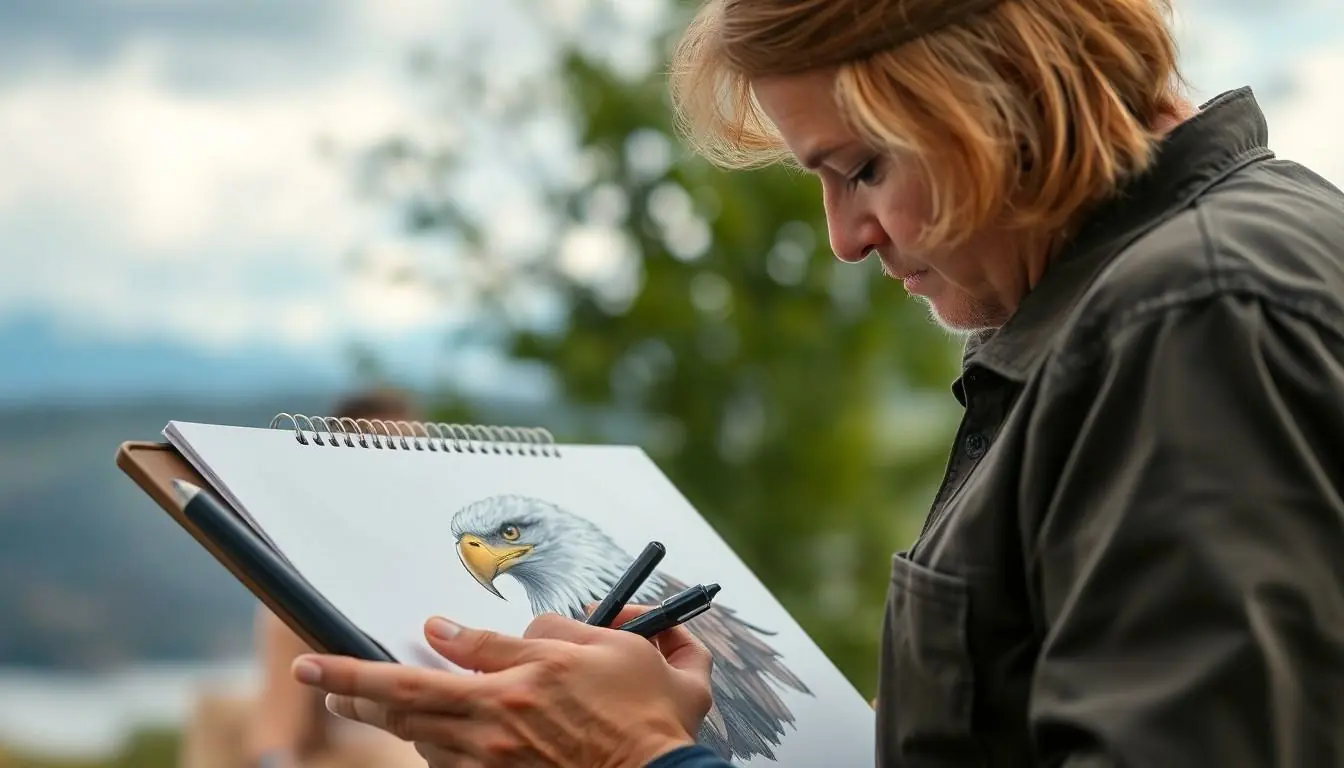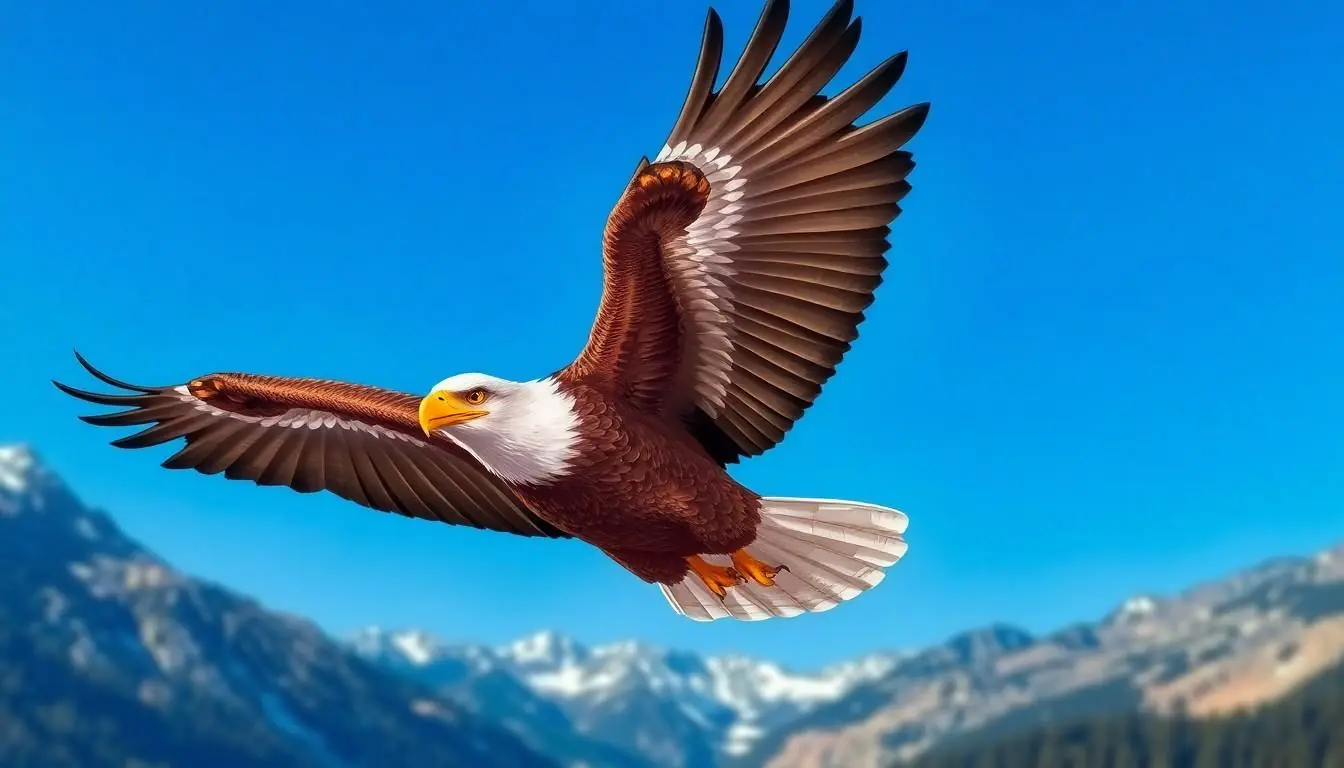Table of Contents
ToggleEagles are the rock stars of the bird world, soaring high with grace and power. Their majestic wings and piercing eyes can inspire even the most hesitant artist to pick up a pencil. Whether it’s a quick sketch or a detailed masterpiece, drawing an eagle can be a thrilling adventure that unleashes creativity and sharpens skills.
Overview of Eagle Drawings
Eagle drawings capture the essence of strength and beauty. Artists often convey the eagle’s fierce gaze and impressive wingspan through various techniques. Detailed illustrations showcase feathers with intricate lines, highlighting the bird’s majestic appearance. Quick sketches tend to emphasize movement, portraying the eagle in flight or perched loftily.
Various mediums can be used for eagle drawings, including pencils, charcoal, and digital software. Each medium allows for different expressions, whether it’s the softness of a pencil sketch or the boldness of a digital painting. Artists frequently study eagle photographs to understand anatomy and posture, ensuring accurate representation in their work.
Tutorials and instructional videos serve as valuable resources for aspiring eagle artists. These materials often break down the drawing process into manageable steps, boosting confidence and skills. Learning to draw eagles not only enhances artistic abilities but also deepens appreciation for the magnificence of these birds.
Artistic inspiration can be drawn from nature, observing eagles in their natural habitat. Artists might visit wildlife reserves, sketching eagles directly from life, which adds authenticity to their artwork. Combining observation with artistic techniques leads to stunning, lifelike representations.
Eagle-themed drawings hold symbolic meaning in many cultures. They frequently represent freedom, power, and vision, making them popular subjects for various art forms. Creating eagle artwork allows artists to connect with these deeper themes while exploring their creativity.
Techniques for Drawing an Eagle


Eagle drawings can be achieved through various methods, allowing for both precision and creativity.
Sketching the Outline
Begin with simple shapes to establish the eagle’s form. Utilize circles and ovals to define the head and body. Create lines to indicate the direction of the wings and tail. Adjust proportions as necessary to capture the eagle’s grandeur. Focus on the beak, ensuring its sharpness accentuates the bird’s fierce appearance. Always refine lines, maintaining accuracy in the initial sketch. This foundation sets the stage for more intricate work.
Adding Details and Textures
Incorporate intricate feather details to enhance realism. Use short, curved strokes to depict individual feathers across the wings and body. Consider layering different pencil pressures to create depth and contrast. Highlight areas with light shading to mimic sunlight reflecting off feathers. Focus on the eyes, as they convey intensity and character. Incorporate texture in the claws and beak for added authenticity. Every detail contributes to a lifelike representation that captivates the viewer.
Materials Needed for Eagle Drawings
Creating eagle drawings requires specific materials that enhance the artistic process. Artists find that choosing the right tools makes a significant difference in the quality of their work.
Recommended Pencils and Paper
Graphite pencils, ranging from H to B grades, offer a versatile foundation for eagles’ drawings. A softer pencil, such as a 4B, provides rich darks, ideal for deep shadows. Selecting smooth drawing paper supports detailed textures while handling various pencil grades. Consider using heavyweight paper for durability, especially during blending and shading. Many artists prefer sketchbooks designed for pencil work; they present a convenient option for sketches or practice.
Optional Tools for Enhancements
Charcoal can accentuate the depth of an eagle’s feathers, adding dramatic contrasts. Blending stumps help smooth out graphite or charcoal, producing a polished look. Additionally, erasers, both kneaded and rubber, play crucial roles in refining details. Stencils may assist with creating consistent shapes or outlines, particularly for wing structures. Digital tools like tablets offer unique opportunities for experimenting with styles and techniques, allowing artists to explore their creativity in innovative ways.
Famous Eagle Drawings and Artists
Renowned artists have crafted iconic eagle drawings that capture the bird’s essence. One notable piece is John James Audubon’s “The Bald Eagle,” showcasing intricate detail and movement. Audubon’s mastery in depicting nature sets a high standard for wildlife art.
Another famous representation comes from Charles Marion Russell, who illustrated eagles within the context of Native American life. His work provides cultural depth to the significance of eagles as symbols of freedom and power.
Contemporary artist Robert Bateman specializes in wildlife paintings, with eagles among his most celebrated subjects. His realistic style combines careful observation with a deep appreciation for nature, resonating with art enthusiasts and conservationists alike.
Digital artworks, like those by artist Lisa Copeland, expand the boundaries of eagle representations. Through vibrant colors and innovative techniques, Copeland captures the majesty of eagles in contemporary formats, appealing to a modern audience.
Students can also learn from tutorials by accomplished artists who share their techniques for drawing eagles. Online platforms feature videos from artists like Proko and Aaron Blaise, who emphasize essential skills in capturing the eagle’s form and spirit.
Exhibitions often showcase eagle art, providing a platform for various artists to express their interpretations. Events like the annual Birds of Prey Festival highlight both traditional and modern styles, encouraging new talent to develop their skills.
Artist communities and forums, such as DeviantArt, foster collaboration and feedback on eagle drawings. Engaging with these groups equips artists with insights and motivates them to refine their techniques further.




